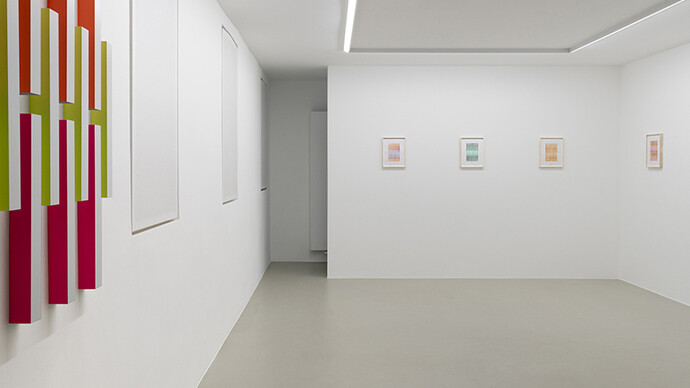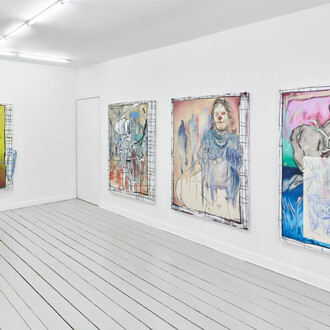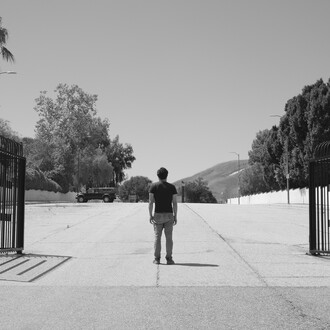Infinite ground, Rana Begum’s solo exhibition at Galerie Christian Lethert, sees the London-based artist focus on the boundless relations and interactions of color. The exhibition extends throughout the entire gallery and includes relief works, paintings, and works on paper.
Three of Begum’s bar works are distributed throughout the exhibition, forming the foundation of this show. She has been making this series for nearly two decades, and they have inspired all of the other works in Infinite ground. These wall-mounted reliefs, made up of powder-coated aluminum box sections have created an interplay of color, geometry and light. Moving around the work, you discover its dual identity, with the bold, fluorescent side contrasting with the softer, calmer pastels. The combination of the two sides allows for new colors to emerge, in the spaces where they meet.
This relationship of color and light has been a continuous interest for Begum and is made tangible on a flat plane by the wall painting No. 1540. A site-specific work, it interacts with the architecture of the space and has the possibility to extend infinitely. The layering of colors creates depth and rhythm on a two-dimensional plane. Despite their sharp edges, the colors blur and soften into one another from afar, becoming more distinct as the work pulls you closer.
The focus changes in the next room, as the scale shifts, allowing for a quieter, more intimate experience of color. The palette reflects Begum’s consideration of dawn and dusk, and how these in-between moments exist. This series of panel paintings go from deep, opaque colors through to pale, metallics, playing with closeness and contrast. The connection between colors sometimes intensifies or softens, vibrates or holds still. Once again, new, sometimes unexpected colors emerge through the layering or combining of colors. Contained by their frames, and hung in a frieze, they offer up space for contemplation.
Downstairs, studies on paper provide softness and transparency, both in terms of the paper support, and the light washes of watercolor. These pieces, made during the pandemic, are the result of a meditative process. The way the colors sit beside one another is reminiscent of the reflection of color emanating from the bar works. They have a delicate touch, embrace imperfection, but they are insistent in their plurality. The repetition seen here, and across the exhibition underscores Begum’s intensive and sustained engagement in color, light and space.
Always interested in further refining works and pushing the process, the three paintings located on the stairs are a departure from the previously more complex panel paintings. Using the four colors of the Palestinian flag, repeated and shifting in size, these formally simple works are an explicit expression of her long-term support for causes of human rights and justice.
















